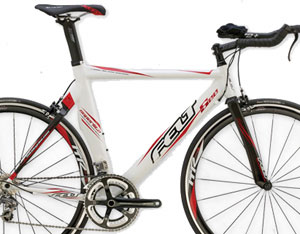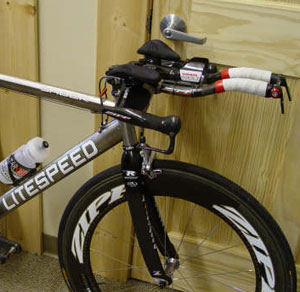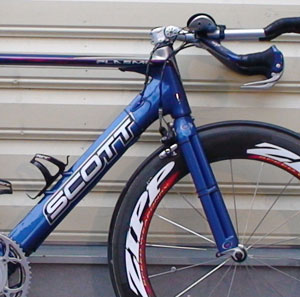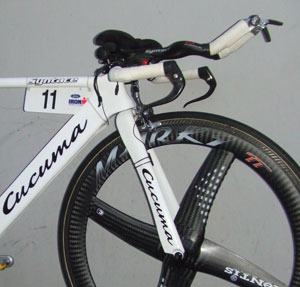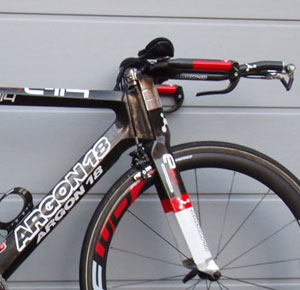Jordan Rapp’s Felt DA

Today we are taking a closer look at the Felt DA of Jordan Rapp for our series "the bikes of the pros." Jordan has posted some of the fastest bike splits in a few races he has entered and we wanted to know more about his setup.
ST: We know that you wouldn’t just ride any bike, so can you tell us what made you select the Felt DA?
Jordan: Zipp was the first company I signed with for this season and they were really interested in having me ride the VukaAero bar setup. So Dan fit me to my position on that bar, and we took the stack and reach measurements of the bike that fit underneath the bars. There were a bunch of frames that would have fit me well with only minor adjustments to my preferred stem configuration. I didn't want to run an overly long or short stem or something with a crazy pitch. So once I had the bikes that worked for me geometrically, I narrowed them down to bikes that I felt were well engineered, especially with regards to aerodynamics. From there I narrowed it down (or had it narrowed down) by what companies were interested in working with me as an athlete and also giving me some level of access to the engineering side of the company. Felt was actually the best match geometrically, the aerodynamics of the bike are excellent, and, fortunately, they were excited to have me ride their bikes and appreciated my background as an engineer, so it all worked out really well.
ST: Has your position changed since you moved to the Felt?
Jordan: Not at all. I really picked the Felt because of my position. My position has been pretty much static for about three years now. Well, that's sort of a lie since my seat height has gone up from last year, but that's because Dan moved my cleats so I drop my heel less, and I had to raise my saddle to account for that. John Cobb narrowed my armrests a bit this spring, which I couldn't do easily on my old aerobars. But neither one is a function of the bike, and those are the only changes I've made in the past few years. Just want to be thorough.
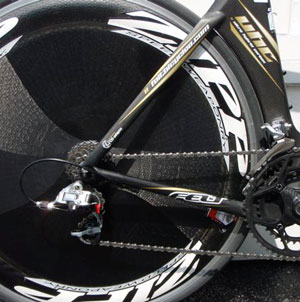
ST: Why Powertap versus any other powermeter?
Jordan: One of the big reasons was that Saris was interested in having me ride their stuff. It's always nice to have a company be interested in you, especially when that company is clearly interested in racing. Saris has really made a lot of improvements to the original PowerTap system, and I was really encouraged seeing first the Phonak team and now Garmin-Chipotle ride PowerTaps in the big races. That underscored what I felt was a commitment to quality and performance, which is obviously hugely important with a powermeter. I also like the idea of having the powermeter in the wheel, since this was the first year I have both a road bike and tri bike, and the easy-swap between bikes is wonderful, especially as I regularly ride one bike in the morning and the other in the evening on days when I do double rides. Initially, I was a bit hesitant about what I'd do for race wheels since I prefer to ride a disc, but the new PowerTap discs that Zipp made for this year eliminated that. Wheel covers are a great option, but I was happy to have the PowerTap disc as it is lighter than a covered 808 or 1080 would have been. Being able to choose my own crankset was also important, with the Zipp VumaQuad crankset and PowerTap disc weighing about a half pound lighter than the SRM I had and a regular disc. So that was a great way to save some weight, which is nice when you are committed to riding clinchers. Lastly, not having to deal with any wires is a bonus, as creative as I have been in the past about hiding them.
ST: The rear brake on your bike is different from the front one. Can you explain your choice?
Jordan: The Zipp VumaQuad crankset has a very narrow Q-Factor; I believe it is the narrowest production crankset you can buy (excluding something like the CAT Cheetah where the crankset is unique to the bike). You can see from the pictures how thin the bearing cups are. As a result, I could not use any of the regular dual-pivot brakes. The frame itself is somewhat limited even with a regular crankset due to the brake’s location, but with the narrower Q-Factor, I had a real challenge. The Oval A-700 “scissor” brake is both very narrow and doesn’t change width at all when you engage the brakes, so it was really the best (and maybe only) choice. It's still a tight fit, but it works.
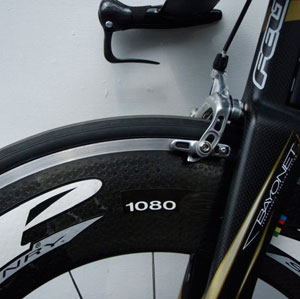
ST: Can you tell us why you opted to ride the clincher versions of the Zipp wheels versus the tubulars?
Jordan: For me, practicality is the really the number one reason. When I rode tubulars (which I did for a couple years), I was always so nervous about flatting doing a workout leading up to a race. Really gluing a tubular on well takes time, and if you flat the day before your race, that’s not enough time to safely glue up a new tire. With clinchers, I feel much safer about training on my race wheels, which gives a peace of mind that I value around a race. That may come as a surprise to people who expected me to say speed. I think the speed issue is less of a determinant. Tubulars are lighter and you can make them a bit more aerodynamic since the clincher rim interface is not ideal. As a result, I think you can have equally fast wheels in either case. However, if you glue your tubulars well enough to have them roll really fast, you aren’t going to change them in a race (e.g. Normann Stadler in Kona 2005). It's also easier to find clinchers that are fast and have good puncture resistance. With tubulars, the fastest ones are usually expensive and aren’t particularly puncture resistant. Speed is obviously king, but with speed being probably equivalent if you pay attention to the details, convenience, puncture resistance, and all those other things become the deciding factors. The best clincher tires are also generally cheaper, which is important since tires are cheap enough that I like having flexibility with regards to what tires I ride. Tubulars really only have a place in my mind for draft-legal racing, since you can safely ride them when they are flat, or for hill climb races where weight can become a big factor.
ST: The 1080 is quite a deep front wheel and we'd love to hear under which conditions you'd use a shallower wheel instead?
Jordan: I was out riding before Lifetime Fitness when a tornado watch was on in the area. When I'd get hit with big gusts, it was a bit scary. But so far that’s the only time I've ever been nervous riding the 1080. You just have to relax and lean the wheel into the wind a bit, just like you are sailing. It's really very steady. I'd probably go to a shallower wheel up front on a course with a lot of rollers, since the 1080 is a heavy wheel, and riding clinchers I'm paying even more of a weight penalty. Ironman Canada comes to mind with the big rollers and long climbs. Or if it was a really gusty day where it’s just not worth risking that you are going to be fighting the wheel for 112 miles; it's the gusts of wind, rather than the strength of wind, that really seems to make a wheel unsteady. I also might opt for a shallower wheel for a really technical course, but I just don't think we generally have too many of those in triathlon, at least outside of the ITU. The shape of the 1080 is also very forgiving of tire width. You can run almost any width tire without paying an aerodynamic penalty, so that makes the wheel harder to give up even on a course where it might be less ideal in parts, since it really solves a couple of the problems that clincher wheels traditionally suffer from aerodynamically. It's just a very fast wheel objectively speaking, and that's hard to give up based on a decision that is really so subjective like "hilliness" or "technicality" or "gustiness" (if that's even a word).
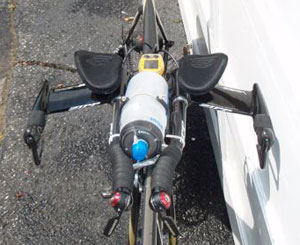
ST: Your aero bar drinking system is quite unique. Can you tell us more about it?
Jordan: There are a handful of pros (all of whom I think are on Slowwitch) who run this setup, but I can't take credit for it. VisionTech's DrinkMore aerobar bottle mount was sort of the first, but I think it's very expensive for what it is, and I don't think it's the most secure. The idea of using a regular bottle cage up there came from my buddy Jonathon Caron. I initially had it mounted on the stem for Ironman Arizona, but in between the bars it actually fills the void there and improves the overall aerodynamics of your bike. Morgan Nichol of Oval Concepts is working on an "aerobar bra" that works in a similar fashion to fill that void, but from my perspective, a bottle cage is more useful.
Bike details and numbers:
– frame: Felt, DA
– size: 56cm
– bar drop: 19.5 cm
– saddle setback: 0 cm (tip to center of BB)
– saddle height: 82.5 cm (center of BB to center of saddle)
– fork: Felt Bayonet, DA
– seat post: Felt, DA, dual-position (rear position removed, forcibly!)
– saddle: Fizik Arione Tri2 carbon with titanium rails
– stem: Felt Bayonet, 110mm
– bars: Zipp VukaAero
– extensions: Zipp VukaShift for SRAM with Zipp Bar Tape
– cranks: Zipp VumaQuad 175mm 53/39 with ceramic bottom-bracket
– rear derailleur: SRAM RED
– front derailleur: SRAM RED
– shifters: SRAM TT
– cassette: SRAM RED 11/23
– chain: SRAM PC-1090R
– brake levers: Zipp VukaAero integrated
– brakes: SRAM RED front // OvalConcepts A-700 rear
– wheels: Zipp PowerTap clincher disc rear // 1080 clincher front with Zipp titanium skewers
– tires: Michelin ProRace3 with Michelin AirLight latex 18-20mm tubes
– bottle cages: Trek Batcage (custom modified)
– bottle: Camelback BPA Free
– pedals: Speedplay Zero Stainless



